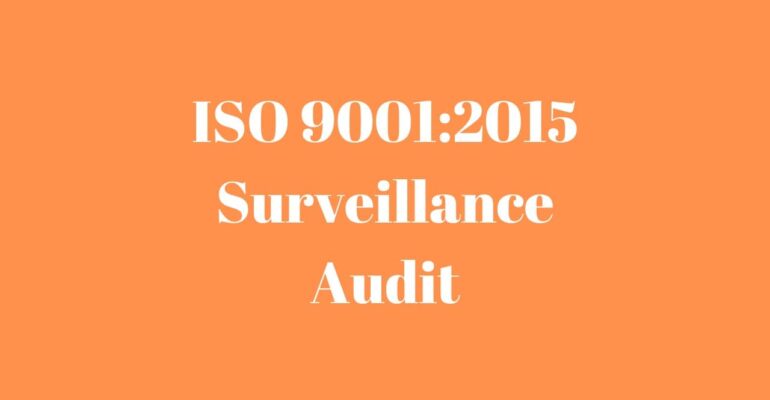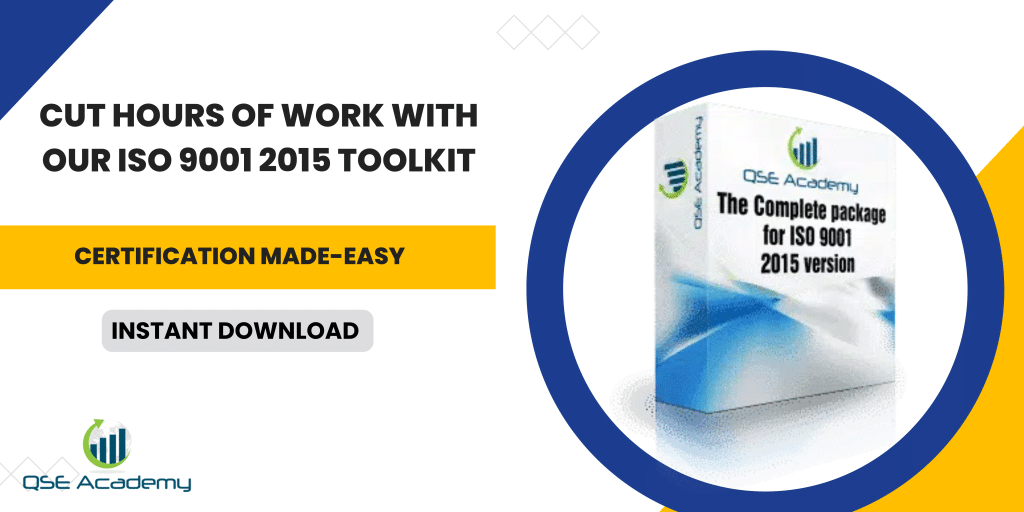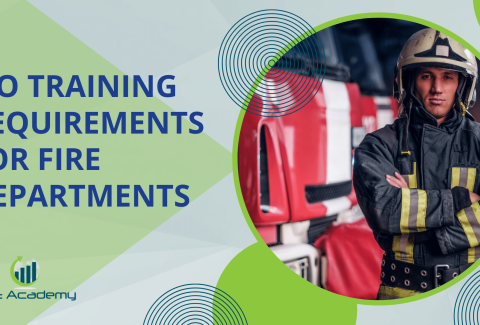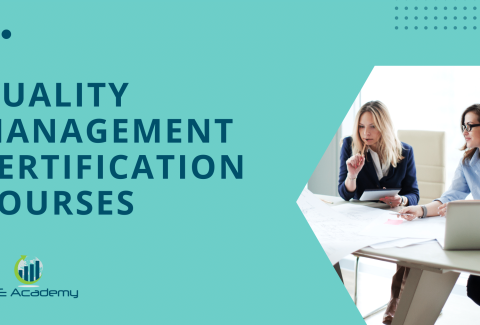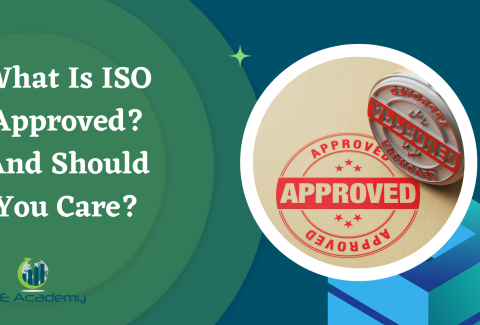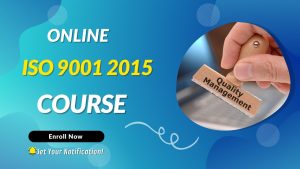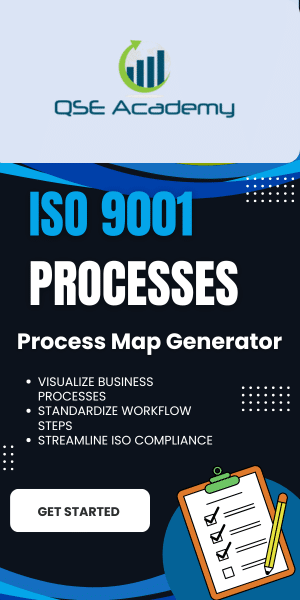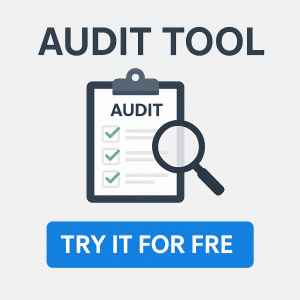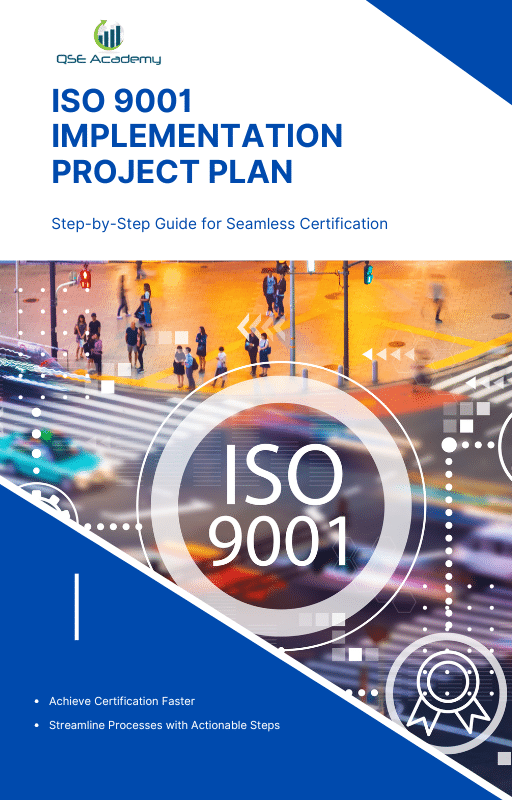ISO 9001 2015 Surveillance Audit
Last Updated on October 13, 2025 by Hafsa J.
ISO 9001 2015 Surveillance Audit
So, you’ve achieved ISO 9001 certification—congratulations! That’s a huge milestone. But now you might be asking, “What comes next?” This is where the Surveillance Audit enters the picture.
A Surveillance Audit is a periodic check-up on your quality management system (QMS) to ensure you’re still meeting the ISO 9001:2015 standards. Think of it as a regular maintenance check for your certification—it keeps everything running smoothly and helps you stay on track with quality goals.
In this article, we’re going to dive into what a Surveillance Audit is, why it’s important, and how you can prepare for it. By the end, you’ll see it not as a stress point but as a valuable opportunity for your business to shine. Ready to get started? Let’s go!
What Is a Surveillance Audit?
If you’re new to the concept of a Surveillance Audit, don’t worry—you’re not alone. It’s one of those terms that can sound more intimidating than it actually is. But here’s the thing: a Surveillance Audit is less about pointing out flaws and more about ensuring your quality management system (QMS) is still working as intended.
Definition and Purpose of a Surveillance Audit
A Surveillance Audit is essentially a periodic review conducted by a certification body to ensure that your organization continues to meet the ISO 9001:2015 standards. Think of it as a follow-up to your initial certification audit—a way to verify that you’re maintaining compliance and continuously improving your processes.
The purpose isn’t to trip you up but to make sure you’re on the right path. It’s about confirming that your QMS is still effective and aligned with the goals of the ISO 9001 standard.
How It Differs from the Initial Certification Audit
You might be wondering how a Surveillance Audit differs from the initial certification audit. Here’s a simple breakdown:
- Scope: The initial audit is more comprehensive, covering every clause of the standard to ensure your QMS meets all requirements. A Surveillance Audit, on the other hand, focuses on specific areas of your system to verify ongoing compliance.
- Frequency: Certification audits happen once every three years, while Surveillance Audits are typically conducted annually.
Example:
If your initial certification audit reviewed everything from leadership involvement to operational controls, a Surveillance Audit might focus specifically on areas like risk management, corrective actions, or how well you’re meeting your quality objectives.
Frequency of Surveillance Audits
Here’s an important detail: a Surveillance Audit isn’t a one-time thing. It’s part of a cycle that keeps your certification valid. Typically, these audits occur annually during the three-year certification period.
The schedule ensures that your QMS is consistently evaluated and gives you the opportunity to address any potential issues before they grow into bigger problems.
Example:
Let’s say you earned your ISO 9001 certification in January 2023. Your certification body would likely schedule your first Surveillance Audit for January 2024, with subsequent audits in 2025 and a full recertification audit in 2026.
Why Understanding the Surveillance Audit Matters
Knowing what a Surveillance Audit is and how it works can help you approach it with confidence. Rather than seeing it as a burden, think of it as a chance to prove that your QMS is strong, reliable, and aligned with the ISO 9001:2015 standards.
In the next section, we’ll explore why these audits are so important—not just for maintaining certification but also for driving continuous improvement in your organization. Let’s keep going!
Why Surveillance Audits Are Important
Now that you know what a Surveillance Audit is, let’s talk about why it matters. At first glance, you might think these audits are just about keeping your ISO 9001 certification intact—and while that’s true, there’s a lot more to it. A Surveillance Audit is an opportunity to strengthen your processes, build trust with stakeholders, and ensure your organization stays on the path to continuous improvement.
1. Maintaining Certification
Let’s start with the obvious: passing your Surveillance Audit is crucial for keeping your ISO 9001 certification valid. If your organization fails to meet the requirements during these periodic checks, there’s a risk that your certification could be suspended or revoked.
But it’s not just about meeting requirements for the sake of it. Maintaining certification shows your customers, partners, and employees that your commitment to quality isn’t a one-time thing—it’s a consistent, ongoing effort.
Example:
Imagine a logistics company whose clients rely on timely, error-free deliveries. Keeping their ISO 9001 certification through successful Surveillance Audits reassures those clients that the company has strong systems in place to deliver on its promises.
2. Driving Continuous Improvement
The ISO 9001:2015 standard emphasizes continuous improvement, and a Surveillance Audit is the perfect opportunity to demonstrate that you’re making progress. These audits encourage businesses to regularly assess their processes, identify areas for improvement, and implement changes to boost efficiency and quality.
How It Helps:
- Spot inefficiencies that might otherwise go unnoticed.
- Keep your team focused on achieving quality objectives.
- Address risks proactively before they become bigger issues.
Example:
A small manufacturing company might use feedback from a Surveillance Audit to fine-tune its inventory management system, reducing waste and improving delivery times.
3. Building Stakeholder Confidence
One of the biggest benefits of a successful Surveillance Audit is the trust it builds with stakeholders. Whether it’s your customers, suppliers, or regulatory bodies, passing these audits demonstrates your organization’s commitment to quality and compliance.
Why It Matters:
- Customers feel more confident in your ability to deliver reliable products or services.
- Suppliers trust that your processes are efficient and won’t disrupt their workflows.
- Regulators see that you’re adhering to industry standards, reducing the risk of compliance issues.
Example:
A tech startup undergoing a Surveillance Audit can use the results to reassure investors that their operations are robust and scalable, making them a safer bet for funding.
Seeing the Bigger Picture
When you look beyond the paperwork, a Surveillance Audit is so much more than a certification checkpoint. It’s a chance to step back, evaluate how far you’ve come, and identify ways to get even better.
In the next section, we’ll dive into practical tips for preparing for a Surveillance Audit, so you can approach it with confidence and a clear plan. Let’s keep going—you’ve got this!
Preparing for a Successful Surveillance Audit
So, you know what a Surveillance Audit is and why it’s important. Now comes the big question: How do you prepare for it? Don’t worry—getting ready for a Surveillance Audit doesn’t have to be stressful. With the right approach and some preparation, you can tackle it confidently and smoothly. Let’s break it down step by step.
1. Review Your Quality Management System (QMS)
Your QMS is the backbone of your ISO 9001 certification, so it’s the first place to start when preparing for a Surveillance Audit. Take the time to review your documentation, processes, and procedures to ensure everything is up to date and aligned with the ISO 9001:2015 requirements.
What to Review:
- Policies, procedures, and work instructions.
- Records of past audits and corrective actions.
- Evidence of progress toward quality objectives.
Example:
A healthcare provider preparing for a Surveillance Audit might review its patient care protocols to ensure they match the latest industry standards and align with ISO 9001 requirements.
2. Conduct Internal Audits
Internal audits are like a dress rehearsal for your Surveillance Audit. They give you a chance to spot potential issues and address them before the official audit. Plus, they help you stay proactive about maintaining compliance.
How to Make the Most of Internal Audits:
- Follow the same structure and scope as the external Surveillance Audit.
- Focus on high-risk areas, like customer complaints or process bottlenecks.
- Use the findings to implement corrective actions and improve your QMS.
Example:
A retail company might conduct an internal audit focusing on customer feedback and returns processes, identifying areas to streamline before the Surveillance Audit.
3. Train and Involve Your Team
Your team plays a crucial role in a successful Surveillance Audit. Auditors may ask employees questions about their roles and responsibilities, so it’s important that everyone is on the same page.
How to Prepare Your Team:
- Provide training on ISO 9001 requirements and the purpose of the audit.
- Share an overview of the audit process so employees know what to expect.
- Encourage open communication so your team feels comfortable asking questions or sharing concerns.
Example:
A logistics company might hold a workshop for drivers and warehouse staff to explain how their daily tasks contribute to meeting ISO 9001 standards, ensuring they’re ready to answer any questions from auditors.
4. Check Your Records and Evidence
A Surveillance Audit often involves a detailed review of your records to ensure you’re meeting ISO 9001 requirements. Make sure all your evidence is organized, accessible, and up to date.
Key Records to Review:
- Customer feedback and satisfaction metrics.
- Records of risk assessments and corrective actions.
- Performance metrics aligned with your quality objectives.
Example:
A manufacturing company might prepare production logs, supplier evaluations, and quality control reports to demonstrate consistent compliance during their Surveillance Audit.
5. Stay Calm and Confident
Finally, remember that a Surveillance Audit is not meant to catch you off guard—it’s a collaborative process. Approach the audit with confidence, knowing that you’ve done the work to maintain your QMS.
Mindset Tips:
- Treat the audit as an opportunity to showcase your strengths and learn from any feedback.
- Maintain open and honest communication with the auditors.
- Focus on the bigger picture: continual improvement and long-term success.
Why Preparation Is Key
Preparing for a Surveillance Audit is all about being proactive and organized. By reviewing your QMS, conducting internal audits, involving your team, and gathering the right evidence, you’re setting yourself up for success—not just for the audit, but for your business as a whole.
In the next section, we’ll explore what happens during the Surveillance Audit itself, so you know exactly what to expect. Let’s keep the momentum going!
What to Expect During a Surveillance Audit
Now that you’ve prepared for your Surveillance Audit, you might be wondering, “What actually happens during the audit?” Don’t worry—it’s not as intimidating as it sounds. Understanding the process can help you feel more confident and ready to showcase your quality management system (QMS) in action. Let’s walk through what you can expect during a Surveillance Audit step by step.
1. The Audit Process: How It Works
A Surveillance Audit typically begins with an opening meeting where the auditor explains the scope of the audit, the key areas they’ll focus on, and the timeline for the day. This is your chance to ask any questions and clarify expectations.
From there, the auditor will dive into reviewing your QMS. This includes:
- Examining your documentation, such as policies, procedures, and records.
- Observing processes in action to ensure they align with the ISO 9001:2015 requirements.
- Interviewing employees to confirm their understanding of their roles and responsibilities.
Example:
During a Surveillance Audit at a manufacturing plant, the auditor might observe the assembly line, review maintenance logs, and interview team leads to confirm compliance with safety and quality standards.
2. Common Areas of Focus
While the exact focus of a Surveillance Audit can vary depending on your organization, there are a few areas auditors typically pay close attention to:
- Leadership Involvement: How engaged is your leadership team in the QMS? Are they driving a culture of quality?
- Risk Management: Are you identifying and addressing risks effectively to maintain consistent quality?
- Continuous Improvement: What steps are you taking to improve your processes and meet quality objectives?
- Customer Satisfaction: How are you monitoring and enhancing customer satisfaction?
Example:
A tech company undergoing a Surveillance Audit might be asked to demonstrate how they handle customer complaints, track resolution times, and use feedback to improve their software development process.
3. Addressing Nonconformities
If the auditor identifies any nonconformities—areas where your QMS doesn’t fully meet the ISO 9001:2015 requirements—don’t panic. Nonconformities are a normal part of the process and an opportunity to improve.
What Happens If Nonconformities Are Found?
- The auditor will document the issue and explain why it doesn’t meet the standard.
- You’ll have a chance to discuss and clarify the finding with the auditor.
- You’ll then need to develop a corrective action plan to address the nonconformity within a specified timeframe.
Example:
A logistics company might receive a nonconformity for inconsistent driver training records. To address it, they could implement a new training schedule and tracking system to ensure compliance moving forward.
4. The Closing Meeting
At the end of the Surveillance Audit, there’s a closing meeting where the auditor provides a summary of their findings. This includes:
- Areas where your organization is doing well.
- Any nonconformities or opportunities for improvement.
- Next steps, such as submitting corrective actions or scheduling the next audit.
This is your chance to ask questions, get clarification, and plan your next steps.
Why Knowing What to Expect Matters
Understanding the Surveillance Audit process can help you approach it with confidence and clarity. By knowing what to expect, you can prepare your team, ensure your documentation is in order, and showcase your QMS in the best light.
In the next section, we’ll share tips for ensuring your Surveillance Audit is a success, so you can approach it as an opportunity to grow and improve. Let’s keep going—you’re almost there!
Tips for a Successful Surveillance Audit
So, you’ve prepared and you know what to expect during a Surveillance Audit. The final step is to ensure the audit goes as smoothly as possible. With a few strategic tips, you can not only pass the audit but also use it as an opportunity to improve and grow. Let’s dive into some practical advice to help you shine during your Surveillance Audit.
1. Keep Your Documentation Up to Date
One of the first things auditors will look at is your documentation. This includes your policies, procedures, work instructions, and records. Keeping these up to date is crucial for a smooth Surveillance Audit.
Tips for Managing Documentation:
- Use a centralized system to store and manage your QMS documents.
- Regularly review and update documents to reflect any changes in processes or policies.
- Ensure employees know where to find relevant documents and how to use them.
Example:
A retail company might update its return policy and ensure the revised version is reflected in its documentation before the Surveillance Audit.
2. Regularly Review and Improve Your Processes
ISO 9001:2015 emphasizes continuous improvement, and your Surveillance Audit is a chance to showcase how you’ve been improving since your last audit.
How to Stay on Top of Improvements:
- Conduct periodic reviews of your processes to identify areas for improvement.
- Implement corrective actions to address nonconformities from past audits.
- Track your progress toward quality objectives and document your achievements.
Example:
A small manufacturing company could show auditors how they reduced production errors by implementing a new quality control checklist.
3. Engage and Train Your Team
Your team plays a vital role in the success of your Surveillance Audit. Auditors may interview employees to ensure they understand their roles within the QMS, so it’s important to keep your team informed and prepared.
How to Prepare Your Team:
- Provide refresher training on ISO 9001 requirements and the purpose of the audit.
- Encourage employees to ask questions or clarify doubts about their responsibilities.
- Create a positive mindset by framing the audit as an opportunity for growth.
Example:
An IT company might conduct a short training session to ensure team members understand how their roles contribute to maintaining the QMS.
4. Communicate Openly with Auditors
During a Surveillance Audit, open communication with auditors can make a big difference. Auditors aren’t there to trip you up—they’re there to help ensure your QMS is effective and compliant.
Tips for Communicating Effectively:
- Be honest and transparent if challenges or gaps are identified.
- Provide clear, concise answers to auditors’ questions.
- Ask for clarification if you’re unsure about a finding or recommendation.
Example:
If an auditor raises a concern about incomplete training records, a logistics company could openly explain the challenges they faced and outline the steps they’re taking to resolve the issue.
5. Stay Organized and Calm
Finally, organization and composure are key to a successful Surveillance Audit. An organized workspace, accessible records, and a confident attitude show that your organization takes quality seriously.
How to Stay Calm and Organized:
- Prepare a checklist of everything you need for the audit, including records and key contacts.
- Assign a point person to guide the auditor and provide support during the process.
- Remind yourself that the audit is an opportunity to showcase your hard work and commitment to quality.
Example:
A healthcare clinic might create a binder with key documents, such as patient feedback reports and corrective action plans, to make the auditor’s job easier.
Why These Tips Matter
By following these tips, you’re setting yourself up for success during your Surveillance Audit. Not only will you demonstrate compliance with ISO 9001:2015 requirements, but you’ll also show a commitment to continuous improvement and quality excellence.
In the final section, we’ll wrap up this guide with a look at how Surveillance Audits contribute to long-term success and why they’re a valuable part of your ISO journey. Let’s bring it all together!
Conclusion: The Value of a Surveillance Audit
A Surveillance Audit might seem like just another box to check, but it’s so much more than that. It’s an opportunity to showcase your hard work, strengthen your quality management system (QMS), and build trust with your stakeholders. By embracing the process and using it to your advantage, you’re setting your organization up for long-term success.
Why Surveillance Audits Matter
The Surveillance Audit plays a vital role in the ISO 9001:2015 framework. It’s not just about maintaining your certification—it’s about proving that your commitment to quality is ongoing. A successful Surveillance Audit helps you:
- Maintain Certification: Keeping your ISO 9001 certification shows your customers and partners that you take quality seriously.
- Promote Continuous Improvement: The audit ensures you’re constantly evaluating and enhancing your processes.
- Build Credibility: Regular audits demonstrate to stakeholders that your organization is reliable, compliant, and forward-thinking.
Example:
A food production company that passes its Surveillance Audit consistently not only maintains its ISO 9001 certification but also gains the trust of retailers and customers who rely on their quality.
What You Gain from the Process
Instead of viewing a Surveillance Audit as a challenge, think of it as an opportunity. It’s a chance to:
- Identify and resolve weaknesses in your processes.
- Celebrate the progress you’ve made since your last audit.
- Gather valuable insights from auditors that can help your organization grow.
Example:
A tech startup might use feedback from a Surveillance Audit to refine its risk management process, making the company more resilient to industry changes.
Your Path to Success
The key to a successful Surveillance Audit lies in preparation, teamwork, and a commitment to quality. Here’s a quick recap of the steps we’ve covered:
- Review your QMS regularly to ensure everything is up to date.
- Conduct internal audits to identify potential issues before the official audit.
- Engage and train your team so they’re confident and prepared.
- Maintain open communication with auditors to foster a collaborative atmosphere.
- Use the audit findings as a roadmap for continuous improvement.
Final Thoughts
A Surveillance Audit is more than just a requirement—it’s a valuable tool for growth and improvement. By embracing the process and seeing it as an opportunity, you’re not just maintaining compliance; you’re building a stronger, more efficient, and more trustworthy organization.
So, as your next Surveillance Audit approaches, take a deep breath, follow the steps we’ve discussed, and remember: this is your moment to shine. You’ve got this!
Ready to move from ISO 9001 theory to implementation?
Get the exact tools you need to write your documentation, train your team, map your processes, and pass your audit—without wasted time or guesswork.

make ISO standards less intimidating and more approachable for everyone.
Whether it’s ISO 9001, ISO 22000, or the cosmetics-focused ISO 22716, I’ve spent my career
turning complex jargon into clear, actionable steps that businesses can actually use.
I’m not here to call myself an expert—I prefer “enthusiast” because I truly love what I do.
There’s something incredibly rewarding about helping people navigate food safety and quality management systems
in a way that feels simple, practical, and even enjoyable.
When I’m not writing about standards, you’ll probably find me playing Piano 🎹, connecting with people, or diving into my next big project💫.
I’m an engineer specialized in the food and agricultural industry
I have a Master’s in QHSE management and over 12 years of experience as a Quality Manager
I’ve helped more than 15 companies implement ISO 9001, ISO 22000, ISO 22716, GMP, and other standards
My clients include food producers, cosmetics manufacturers, laboratories, and service companies
I believe quality systems should be simple, useful, and efficient.

